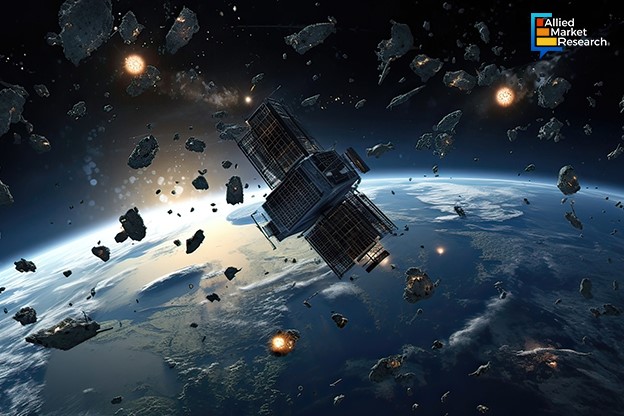How Are Space Companies Reacting to the Growing Importance of Space Debris Monitoring and Removal?

23 Apr
2024
Key takeaways:
- Introduction
- Technologies adopted by leading companies in the sector
- Recent developments in the industry
Space debris or space waste are man-made objects lying across space, especially in Earth’s orbit, which previously performed certain functions, but now have become obsolete. Thus, inactive satellites, abandoned launch vehicles, fragments of broken satellites, unburned particles from solid rocket motors, and other such objects are considered as space debris. Space debris poses a significant threat to space missions, both manned and unmanned, and can hamper the smooth functioning of artificial satellites that have been placed in the Earth’s orbit. Space debris monitoring and removal, thus, becomes an important aspect for ensuring the success of future space missions.
Which technologies are worth investing in for ensuring effective space debris monitoring and removal?
The history of space debris can be traced back to the launch of Sputnik 1, the first-ever artificial satellite. Since then, with the start of the Space Race between the US and the USSR, the volume of space debris increased continuously. In the past few decades, as more countries have developed technology to launch artificial satellites, the amount of space debris has further grown. As per the US Space Surveillance Network, more than 15,000 objects of more than 10 cm and around 2 lakh pieces of less than 10 cm are currently revolving around the Earth in its orbit.
As mentioned earlier, monitoring and removing space debris is one of the most crucial tasks space agencies have to undertake to ensure the success of their space missions. For this, governmental space organizations have roped in private companies to monitor these objects and develop technologies for their safe removal. For instance, the European Space Agency roped in ClearSpace, an in-orbit space services provider based in Switzerland, to launch a mission to clear space debris. Under this program, ESA and ClearSpace will jointly develop ClearSpace-1, a space debris removal mission, which is scheduled to be launched in 2026. As part of this mission, a medium-sized space solution will be developed with a giant four-armed claw to grab and place the debris in Earth’s lower orbit. The debris then burns and disintegrates while reentering the atmosphere.
In a different approach, space companies are providing active debris removal (ADR) services that harness the power of advanced technologies such as the Internet of Things, Artificial Intelligence, and computer vision to detect and remove space debris. These space debris monitoring and removal programs mainly focus on targeting space debris that is smaller than 20 cm. Aircraft manufacturing companies like Airbus have invested heavily in this technology which features a Vision Based Navigation (VBN) system to track debris and signal their location to their system. The unit developed to remove space debris also features a harpoon and a net to capture the junk without harming any nearby functional space objects. The researchers involved in this project have also stated that LIDAR technology could play a huge role in the effective monitoring of space debris.
Understanding the evolving dynamics of the space debris monitoring and removal industry
One major development in the space sector in the past few years is the entry of private companies like SpaceX and Blue Origin which undertake space missions independently without any governmental support. As a result, huge chunks of space debris are generated rapidly with these space missions and satellite launches. This has led to many environmentalists pointing out the degradation of the earth’s outer space and the potential hazards it could have on the atmosphere.
Hence, the demand for space sustainability has increased and many governments across the globe have enacted policies to tackle the issue of space debris. For example, NASA and the US Department of Defense have started chalking out space debris monitoring and removal programs and have also released regulatory norms that commercial space companies must adhere to, for responsible space activities.
Recently, the International Space Station had to maneuver its path and adjust its panels to avoid collision with a massive piece of space junk. Space researchers have commented that the safety of future space missions rests on how quickly and efficiently the existing space debris is being cleared. NASA scientists have even pointed out that these debris, by colliding with each other might further generate more debris, thus putting the lives of astronauts at risk. Many countries in the Asia-Pacific region such as South Korea, China, and India have launched initiatives to reduce the amount of space debris created by space missions. The space debris monitoring and removal industry is predicted to witness huge growth due to these factors across the globe, especially in the Asia-Pacific region.
To summarize, space debris has become a serious problem that poses a threat to future space missions and the lives of astronauts traveling into space. Furthermore, the environmental hazards associated with space debris are also huge. Hence, many space companies are actively investing in new technologies that can help overcome this problem.
To get an in-depth analysis of the growth drivers and investment opportunities in the industry, feel free to contact us.

Akhilesh Prabhugaonkar
Author's Bio- Akhilesh Prabhugaonkar holds a bachelor’s degree in Electronics Engineering from the reputed Vishwakarma Institute of Technology. He has a special interest in the fields of forensics, world history, international relations and foreign policy, sports, agriculture, astronomy, security, and oceanography. An ardent bibliophile and melophile, Akhilesh loves to write on topics of his interest and various other societal issues. This love for writing made him enter the professional world of content writing and pursue his career in this direction.
Air Crane Helicopter: How Advanced Technology Integration Optimizes Operational Efficiency?
Avenue: Entire Library membership of Allied Market Research Reports at your disposal
- Avenue is an innovative subscription-based online report database.
- Avail an online access to the entire library of syndicated reports on more than 2,000 niche industries and company profiles on more than 12,000 firms across 11 domains.
- A cost-effective model tailored for entrepreneurs, investors, and students & researchers at universities.
- Request customizations, suggest new reports, and avail analyst support as per your requirements.
- Get an access to the library of reports at any time from any device and anywhere.
Related Post
-
How are Submarine Cables Transforming Global Connectivity with Enhanced User Experience?
-
Endoscopy Procedures: Transformations in Techniques and Applications
-
AI-Powered Video Analytics: How the Product Actually Works for enterprises
-
Painting Robots: Transforming Precision Coating and Creative Applications
-
Innovations in Pharmacovigilance Systems Advancing Patient Safety
-
Understanding Edge Security: Keeping Data Safe Near the Source
-
Exploring the Use and Advancements of 3D Laser Scanners in Professional Applications
-
Reinforcing Industrial Controls with Smarter Tools and Training








